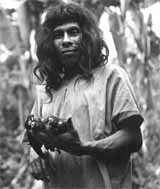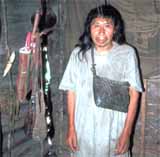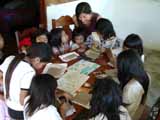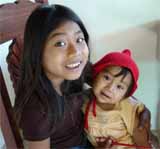Colonial Origins

Lacandon Indian burning incense, Chiapas, Mexico

Lacandon Indian, Chiapas, Mexico

Lacandon Indian, Mensabäk, Mexico

Heather Eiden with Lacandon children doing arts and crafts, Mensabäk, Mexico

Lacandon children, Mensabäk, Mexico

Deforestation near Lacandon house, Chiapas, Mexico
In an effort to escape the Spanish occupation of the Yucatan peninsula during the 17th and 18th centuries, many groups of Mayan peoples (usually described as Yucatec-speaking Kechack and Itzaj Mayas, or the Ch'ol- speaking Ch'olti, Ch'ol and Locen Mayas), moved into the southern lowlands of Chiapas. It is believed that the Lacandon are descended from one or several of these groups of people (Palka 2005:72; Boremanse 1998:3-4; McGee 1990:17-24; McGee 2002:4-18).
There are some questions regarding Lacandon ancestry and cultural origins. The term "lacandon" was a general term used by the Spanish to describe any unconquered indigenous peoples in the lowlands of Chiapas. The word was derived from an indigenous place name lakam tun, which refers to an island in Lake Miramar and more generally to ancient Maya stone stela. There are many people referred to as the Lacandon in historical records who may or may not be the ancestors of the contemporary Lacandon (Palka 2005:73). The contemporary Lacandon share linguistic and cultural traits with the Itzaj and the Kehach, but some of their clothing and religious customs are similar to the Kehach and Ch'olti. In addition, their settlement patterns and subsistence strategies are similar to all lowland Maya populations. Therefore, it is likely that contemporary Lacandon culture developed as a result of interactions between the various groups of peoples who moved into the lowlands of Chiapas during the 17th and 18th centuries (Palka 2005:72-79; Boremanse 1998:4; McGee 2002:4-18).
The first historical records of the Lacandon date to 1646, when a group of friars documented Yucatec-speaking peoples in the area around Najá. One hundred years later, there were reports of two distinct groups, Southern and Northern Yucatec-speaking populations, residing in or near the regions where the Lacandon currently live (Boremanse 1998:3-4; McGee 1990:17-19; McGee 2002:4-18).
Recent History
By the late 1700s, the Lacandon were trading cacao, cotton, corn, animal skins, fruit, and tobacco for metal tools and other goods from missionaries, other Maya groups, and colonists. In 1786, Father Manuel Joseph Calderon, a parish priest of Palenque, met a group of Northern Lacandon who had come to Palenque to trade goods. Although the Lacandon used the parish periodically for trade and medical treatment, they resisted conversion to Christianity (Boremanse 1998:5; Palka 2005:22-26, 56-58, 71; McGee 2002:4-27).
In the mid 1800s, the first large effort by Catholic priests and government officials to convert and relocate the Lacandon outside the forests of Chiapas occurred. Several friars learned Yucatec and baptized as many people as they could find. The sad irony is that these proselytizers infected many Lacandon with smallpox and other deadly respiratory diseases. Also around this time, the Mahogany industry boomed in the Mexican states of Tabasco and Chiapas. Through contacts with lumbermen, the Lacandon traded for salt and iron tools like machetes and fish hooks; however, the lumbermen also encroached upon their land, and exposed them to yellow fever, malaria, and measles. Exposure to logging companies has been and continues to be a source of great change for the Lacandon (Boremanse 1998:4-7; Palka 2005:22-26, 86, 119-122; McGee 2002:4-27, 72-80, ).
There was very little contact with the Lacandon between the collapse of the lumber industry in the 1920s and the end of WWII. In the 1950s, 60s, and 70s, however, a new migration of people into Chiapas resulted in the clearing of large areas of forest for farming and ranching. In light of the rapid changes, the Mexican government decided in 1971 and 1975 to preserve over 662,000 hectares for the Lacandon. In 1974, the Lacandon sold lumber rights in their territories for credit from the National Bank. The money they received is administered by the National Fund for the Promotion of Communal Territories, and is distributed quarterly to every male who has a farming plot, with each man receiving a sum that varies according to his age, marital status, and number of children (Boremanse 1998:7-9; McGee 2002:4-27, 71-124, 72-80, 87-112).
Today the Lacandon rely heavily on money from tourism and the National Bank fund. The Lacandon used the government money to build a general store, purchase a radio, and build a small hospital in each of their communities. As each year passes, they rely less on farming and acquire more western-style goods. In the Southern group at Lacanhá Chan Sayab, a number of men have begun earning salaries working for the oil and lumber companies. Although cross-cultural contact and integration into modern economics and regional politics has brought much change to the Lacandon, they remain a distinct ethnic group with a unique and valuable identity, language, and culture (Palka 2005:287,292; Boremanse 1998:9; McGee 2002:4-27, 71-124).

